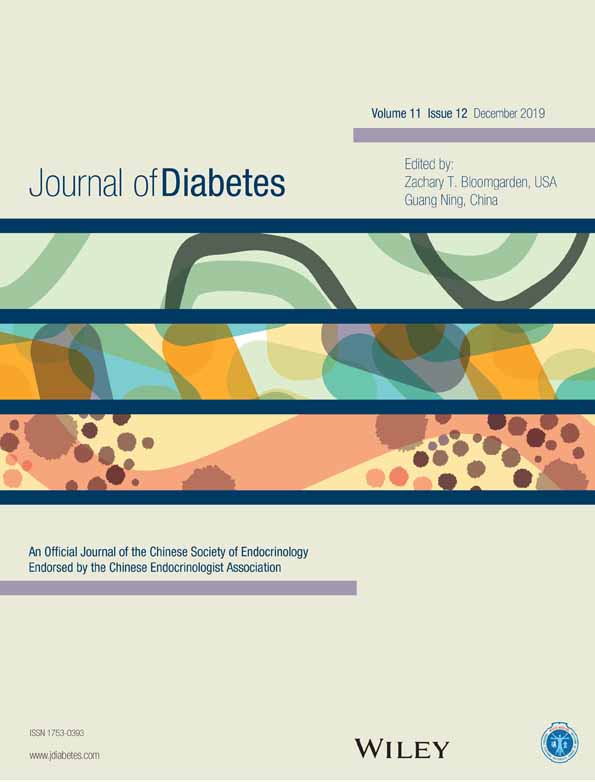Saxagliptin alters bile acid profiles and yields metabolic benefits in drug-naïve overweight or obese type 2 diabetes patient†超重或肥胖的初治2型糖尿病患者服用沙格列汀后胆汁酸组分的改变及代谢获益
Funding information: This study was supported by grants from the National Key R&D Program of China, Grant/Award Number: 2018YFC1314800; Chinese National Natural Science Foundation, Grant/Award Number: 81730023; Shanghai Municipal Education Commission – Gaofeng Clinical Medicine Grant Support, Grant/Award Number: 20161403
Abstract
enBackground
The aim of the present study was to investigate the metabolic benefits of saxagliptin and its effects on serum bile acids (BAs) in normal weight and overweight/obese drug-naïve type 2 diabetes (T2D) patients.
Methods
In all, 282 drug-naïve T2D patients (123 normal weight [NW], with body mass index [BMI] between 19.0 and <25.0 kg/m2; 159 overweight/obese [OW/OB], with BMI ≥25.0 kg/m2) were enrolled in the study and treated with saxagliptin 5 mg daily for 24 weeks. Serum BAs were assayed by liquid chromatography with tandem mass spectrometry.
Results
At 24 weeks, HbA1c was significantly reduced in both groups, but the HbA1c levels were lower in the OW/OB than NW group. Moreover, significant decreases were seen at 24 weeks in C-reactive protein (CRP), aspartate aminotransferase, alanine aminotransferase, waist circumference, and systolic blood pressure in the OW/OB group. Interestingly, cholic acid, glycocholic acid, glycochenodeoxycholic acid, glycodeoxycholic acid (GDCA), and glycoursodeoxycholic acid (GUDCA) were increased in both groups after treatment, whereas chenodeoxycholic acid and deoxycholic acid (DCA) were specifically increased in the OW/OB group. Increased DCA and GDCA concentrations were significantly associated with decreased HbA1c or fasting blood glucose and CRP levels, whereas increased GDCA and GUDCA concentrations were associated with decreased waist circumference in the OW/OB group during treatment. In the NW group, increased GUDCA concentrations were significantly associated with a decrease in HbA1c.
Conclusions
Type 2 diabetes patients with OW/OB exhibited greater improvement in glycemic control and additional metabolic benefits after saxagliptin treatment. Saxagliptin significantly increased the BA pool, and DCA and GDCA were associated with metabolic improvements in OW/OB T2D patients.
摘要
zh背景
本研究旨在探究正常体重和超重/肥胖的初治2型糖尿病患者服用沙格列汀之后, 其代谢获益以及对血清胆汁酸的影响。
方法
本研究募集了282例初治2型糖尿病患者, 根据治疗前的体质指数(body mass index, BMI)分为正常体重组(NW, 19.0<BMI<25.0 kg/m2, n=123)和超重/肥胖组(OW/OB, BMI≥25.0 kg/m2, n=159), 分别接受为期24周, 每天5 mg的沙格列汀治疗, 并使用液相色谱-串联质谱法检测患者血清中的胆汁酸组分。
结果
使用沙格列汀24周后, 两组的糖化血红蛋白(HbA1c)均显著下降, 但OW/OB组患者的HbA1c比NW组下降得更加显著。此外, 在OW/OB组还观察到C-反应蛋白(CRP)、天冬氨酸氨基转移酶、丙氨酸氨基转移酶、腰围和收缩压显著下降。两组患者血清中的胆酸(CA)、甘氨胆酸(GCA)、甘氨鹅脱氧胆酸(GCDCA)、甘氨脱氧胆酸(GDCA)和甘氨熊脱氧胆酸(GUDCA)在用药24周之后均升高, 而鹅脱氧胆酸(CDCA)和脱氧胆酸(DCA)只在OW/OB组患者的血清中升高。在服药过程中, OW/OB组患者血清中DCA和GDCA水平的上升与其空腹血糖以及CRP的下降有显著相关性, 而GDCA和GUDCA水平的上升与腰围的下降有显著的相关性。在NW组患者中可观察到GUDCA的上升与HbA1c的下降有显著相关性。
结论
肥胖/超重的2型糖尿病患者服用沙格列汀之后的血糖控制以及代谢获益更多。沙格列汀可以有效扩大胆汁酸池, 其中DCA和GDCA与肥胖/超重2型糖尿病患者用药后的代谢改善密切相关。




